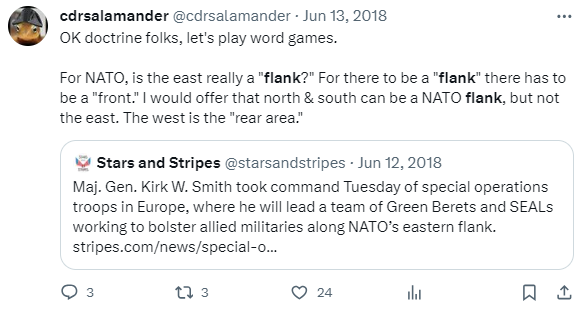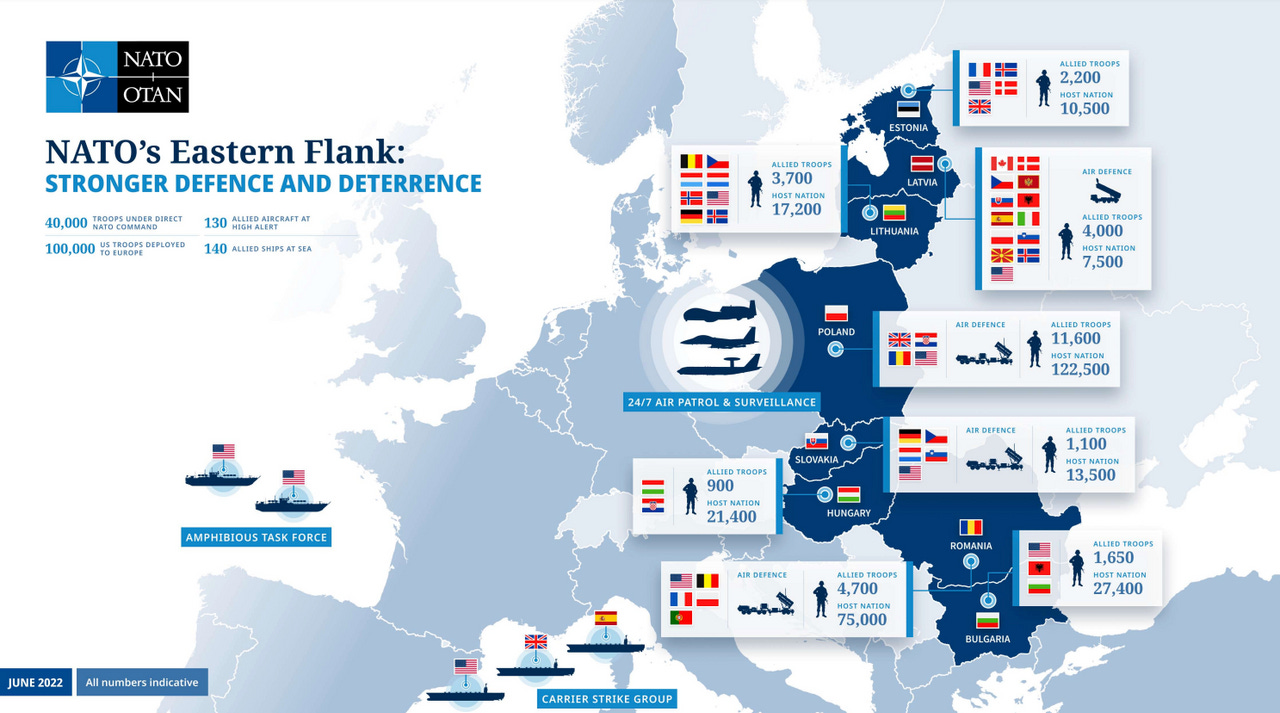For those who follow me on twitter/X, you are quite familiar with the meme I’ve been posting since long before the Russo-Ukrainian War, all the way back to at least 2018.
This misuse of the King’s English soon became a bur under my saddle as this error continued to be made. Seeing a trend, the following meme was generated by a friend;
This is not a new problem, and I know exactly where it comes from. In my years as a NATO Staff Officer, it did not take long to notice a twitch in the eye of many, not only Germans, to the mention of an “Eastern Front.” It seems silly, and in the 21st Century is it, but it is a reality.
I refused to play along. Yes, I understand how a very few highly emotional people can’t let go of their grandfather’s nightmares, but it is time for the adults in the room to just go around them. Anyway, this is the English language, and while there were French and Walloon Waffen SS units along with Hungarians, Romanians, Italians, and a few volunteer Spanish and others now on the NATO bench that fought on the Eastern Front in WWII, it doesn’t have the same impact with them as we don’t discuss such things in polite company.
Eastern Front, Front de l'Est, or Ostfront, we should all have moved along. History - and proper military terminology - have been around for centuries. In any event, it doesn’t bother the Russians one way or the other and you are fooling yourself if you think it does.
The use of “Eastern Flank” instead of “Front” where referring to real military threat to NATO, the Russian Federation, is just childish.
I mean, give this map to any staff officer of the last 500 years and ask them - in whatever language they use (probably French) - “Where is the Front, where are the Flanks, and where is the Rear?”
So, when will DoD or NATO be confronted with their continual use of “Flank” instead of “Front?”
Funny about that, it looks to be about seven months ago in a “Question for the Record”:
This is my comfort zone - let’s continue to have some fun.
As a good NATO Staff Officer, when it comes to the question of language, it is best to reference the appropriate publications.
Because we live in a time of miracles and wonders, all of this is available at the tip of your fingers via NATOTerm, the Official NATO terminology database (NB: as French is the other official NATO language, and a more precise language, the French definitions are there as well. If you know French, it only reinforces my point). Referencing AAP-06 (unreferenced 2021 version here) and AAP-39, both approved 1973-03-01, there are four definitions for:
FRONT
The direction of the enemy.
The lateral space occupied by an element measured from the extremity of one flank to the extremity of the other flank.
The line of contact of two opposing forces.
When a combat situation does not exist or is not assumed, the direction toward which the command is faced.
We run into a slight issue with FLANK as they don’t directly define it. Hard to blame them, really. FLANK is such a commonly accepted term on its face, why define it? It would be as if there was a need to define “water.” However, there are three related terms that imply the meaning of FLANK, especially in light of the clear definition of FRONT given above;
FLANK COMMUNICATIONS
(ACOM P-01, approved 2005-03-01); Communications between adjacent (on left and/or right) Commands/units/formations, normally of equivalent level of command.
FLANK GUARD
(AAP-06 and AAP-39, Approved1973-03-01); A security element operating to the flank of a moving or stationary force to protect it from enemy ground observation, direct fire, and surprise attack.
FLANKING ATTACK
(AAP-06 and AAP-39, Approved1973-03-01); An offensive manoeuvre directed at the flank of an enemy.
Perhaps it would help if we looked to USA doctrinal definitions instead. It would not be the first time a US military senior officer confused what is correct in NATO or English for what is convenient to the American at the moment.
So, let’s look at 2017’s, DOD Dictionary of Military and Associated Terms (DOD Dictionary) from TRADOC.
Well, we have a problem here. Nowhere is FRONT even defined or referenced. Closest you can get is a reference to “front-line troops” in the definition of FORWARD OBSERVER. (NB: I can hear my German NATO colleagues right now going on a 10 minute rant about how bad the US Army is specifically to deal with because they don’t understand the words they use)
What about FLANK? Again, the US Army fails us. No definition of FLANK, but we do have a few associated concepts:
VERTICAL ENVELOPMENT
A tactical maneuver in which troops that are air-dropped, airlanded, or inserted via air assault, attack the rear and flanks of a force, in effect cutting off or encircling the force. (JP 3-18)
WING
…. 4. A flank unit; that part of a military force to the right or left of the main body. (JP 3-09.3)
Now, General Cavoli, USA A is a graduate of Princeton and Yale and wears the two hats of EUCOM and SACEUR. He knows language and knows the terrain better than this three-number CJ-code. I also know he’s well versed in some of our allies’ “sensitivities.” There are other things going on here, and none of them bring anyone in to a good light.
Let’s look at the NATO Concept for Deterrence & Defense of the Euro-Atlantic Area (DDA) that he refers to in his answer, dated 10 OCT 2023.
In the DDA, “flank” is used six times. Every time it is part of the phrase, “eastern flank.” At no point is there a mention of any other flank. A “360-degree approach“ does not mean there are not “flanks” or a “rear” - much less the absence of a “front.” There have always been threats to flanks and the rear - every operational design requires a “360-degree approach.“
Let’s be clear, it appears from the cheap seats that this is political and diplomatic wrong-think being substituted for sound military practice. The politicians and diplomats should be allowed to live in their error in their lane. The military should not willingly be supine to their wrongness.
However, we have agency too. Me, you, and everyone else.
This comes down to two options; either we live in a magical time when words have no meaning, or EUCOM has adopted a false belief for political expediency based upon bad counsel.
I’m sorry, but it is either that or he simply is wrong. If he is wrong, he should be called out on his wrongness. No one is under an obligation to go along; I do not care who he is or what position he holds. I’m not on his staff.
Personally, I do not think he really believes this.
So:
He does not believe that.
He knows you don't believe that.
He knows that you know that he knows that you don't believe that.
But he wants you to nod as if you believe he does.
Live not by lies the old phrase from a great man goes.
OK, the “"L” word is a bit strong as Cavoli from what all I can tell is a man of superior character and intellect in a hard job doing his best. How about “Live not by spin?” Let’s go with that.
We are led by organizations haunted by imaginary demons under the bed of their weakest acquaintances.
This is more than word games. The world is opaque and full of shadows on its own, being unclear in your own language only creates more sub-optimal thinking.
NATO has always had a strategic eastern front. Always will.










When you talk about the Germans and their frustration, it’s there with the Navy, too.
We had a Luftwaffe exchange pilot with us back at VF-101, was an F-104 pilot. Manfred. Great guy.
Anyway, we’re having an All-Instructors Meeting, and we’re trying to hash out some new syllabus stuff. It’s going back and forth, do it this way; no, we tried that, do this; no, we tried THAT, do this! On and on, ‘round and ‘round.
Finally, Manny can stand it no more. He jumps up, yells, “You Americans! I don’t see how you EVER won the War!”...and stomps out of the Ready Room...it was priceless!!
When I was at NATO, the term "Arc of Instability" was used to describe the areas surrounding Europe - North Africa, Middle East, Central Asia and Russia. That term seemed appropriate, included fronts and flanks and encompassed all sorts of threats and problems.